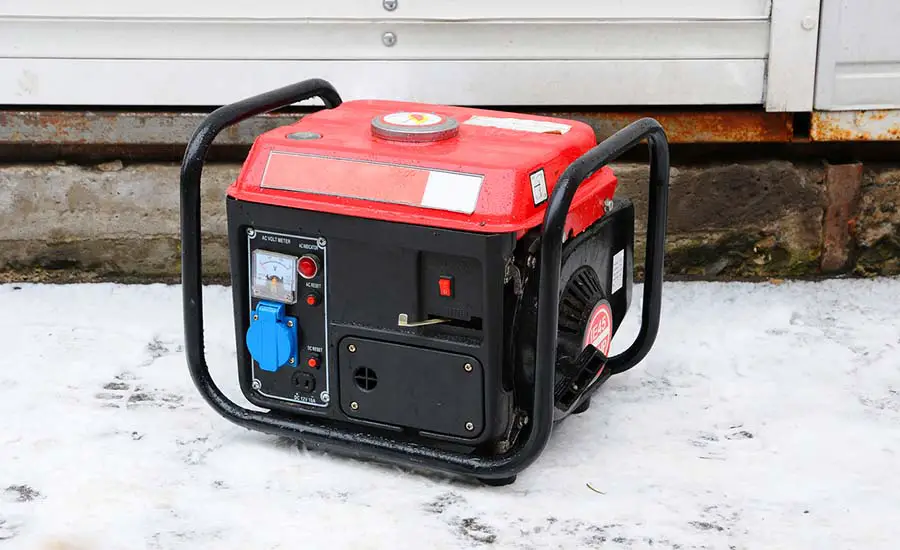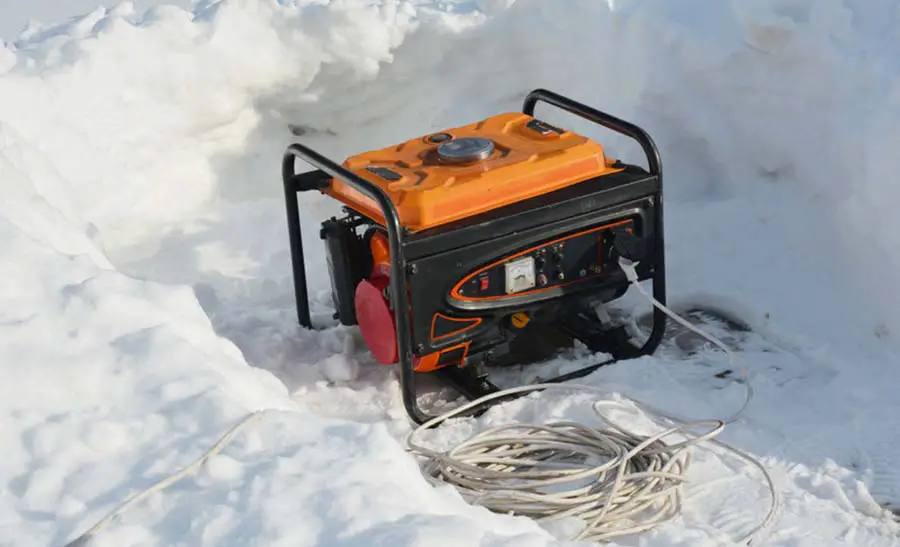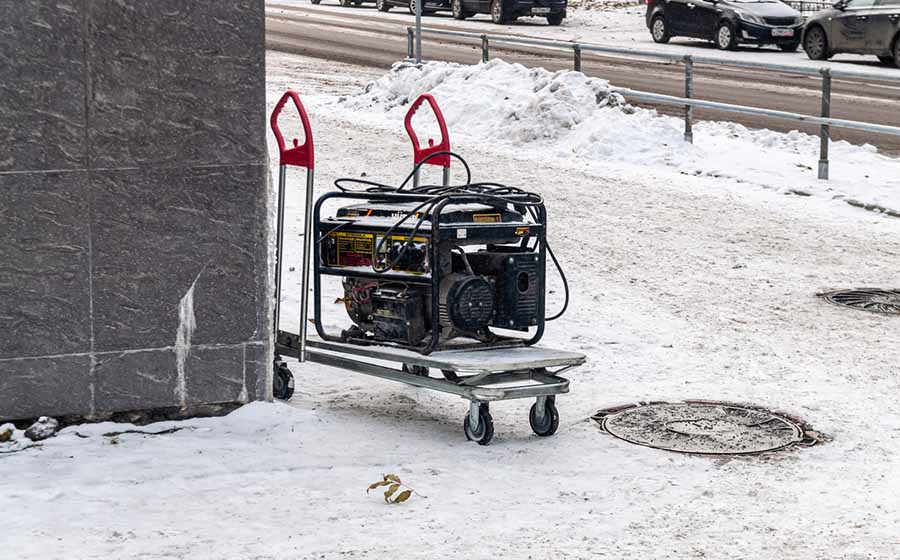
Winter is here, and when your electricity goes out due to a heavy snowstorm, a generator can keep your home powered. However, running a generator during rain or snow can be extremely dangerous. So, we want to discuss all the safety measures you need to take to operate your generator safely in snow conditions.
Keep your generator away from wet areas; moisture may cause electrocution or shock. Avoid operating your generator in places where water can pool or where snow is on the ground. When running a generator in the snow, you should try to elevate the generator off the ground if possible.
This article will review some generator safety basics and cover some dangers when using a portable generator in snow conditions.
How to Safely Use Your Generator In the Snow
Generally, you should not use generators outside during rain or snow based on these two important safety rules. We cannot simply bring the generator indoors either, not even into your garage or shed.
Unfortunately, you cannot always avoid rain and snow, and sometimes we still need power during these conditions. You might be happy to hear that there are options to use your generator in snowy and wet conditions safely.
This option to safely run your generator in the snow provides a cover or builds an outdoor shelter for your generator. You should never operate a generator in snow or rain without having sufficient cover or shelter. When purchasing a generator shelter or cover, make sure it has these three basic requirements:
- It should be able to provide shelter from snow and water from all angles.
- It should allow airflow to pass over the generator. Without good airflow, a generator will quickly overheat and shut down. The generator can also use up all oxygen without good airflow, which will prevent its combustion engine from operating.
- The cover and shelter should be fire-resistant. Electrical outlets can emit sparks, especially with older models. Do not underestimate the risk of fire that is associated with portable generators.
General Generator Safety
Generally, it’s not recommended or safe to use a generator in wet weather like rain or snow. Below are two main safety points, which apply to ALL generators regardless of brand or design, and which are vital for your safety:
- Portable generators must never be operated when wet or when standing in water. Water is a conductor that allows electric current to escape its circuitry and travel elsewhere. Electrocution can be deadly for you.
- Portable generators must never be used indoors. Portable generators burn fuel, which leads to the production of CO. Due to environmental and safety concerns, CO can build up over time and reach lethal concentrations.
16 Generator Safety Tips for Snowy Conditions

- Remember, gasoline is highly flammable and explosive.
- When the generator tank is over-filled, fuel can overflow onto a hot engine and cause fire and an explosion.
- Never overfill the fuel tank. Always give room for fuel expansion in the fuel tank.
- Never add fuel to the tank while the unit is operating or hot. Always let your generator engine cool entirely before adding any fuel.
- Do not store your generator with fuel in the tank. Gasoline vapors can reach an open flame, spark or pilot light and start a fire or explosion.
- Never smoke near fuel or a generator.
- Never operate a generator indoors. Generator exhaust fumes contain carbon monoxide. CO is a deadly poisonous gas you cannot see or smell that can kill you in minutes.
- It is highly recommended to install battery-operated Carbon Monoxide alarms/detectors according to the manufacturer’s instructions and recommendations.
- Avoid contact with a hot generator. Most generator parts are hot enough to burn you during operation and while the generator is cooling after turning off.
- Do not connect a portable generator directly to your household wiring. A generator connected to your home’s wiring directly could ‘back feed’ onto power lines connected to your home and cause injury.
- Only start and stop your generator when no electrical loads are connected.
- Do not overload your generator; it can seriously damage your valuable appliances and electronics. Do not operate appliances and equipment more than the output rating of the generator.
- Make sure you use the correct power cords. Overloaded power cords can cause fires or damage your equipment.
- It is crucial to plugin safely. If you do not have a transfer switch, you can use the outlets on the generator. It’s advised to plug in appliances directly to the generator. It is not recommended to use an extension cord. But if you do, it should be heavy-duty and designed for outdoor use. The extension cord should be rated in watts or amps equal to the sum of the connected appliance loads. Be sure to use extension cords free of cuts, and the plug has all three prongs.
- It is best to install a transfer switch. A transfer switch connects the generator to the circuit panel and allows you to power hardwired appliances. Transfer switches also help avoid overload by correctly displaying wattage usage levels.
- Make sure your generator is correctly grounded. If your generator is not grounded correctly, you could risk electrocution. We cannot strongly recommend enough you check and adhere to all applicable federal, state, and local regulations related to grounding.
Three Options to Safely Operate Your Generator in Bad Weather

There are many options for safely operating your generator in snow and other bad weather, so let’s go over some of the most popular so you can decide which is best for you.
1. Use a Canopy Cover
Tent canopies are one example of protecting your generator from wet weather and allow you to operate your generator in the snow safely.
A tent canopy is waterproof and will protect all the exposed areas of your generator that should not get wet.
A tent canopy does not interfere with the portability of the generator. You can easily set it up and take it down when you need to move your generator to different locations.
This type of cover maintains quality airflow over the generator and promotes natural cooling while safely operating in rain or snow.
2. Use a Steel Enclosure
Another option to protect your generator from rain and snow conditions while operating it is a steel enclosure. Steel enclosures offer a safe way to operate the generator while it is snowing. Unfortunately, steel enclosures are costly and need to be installed by a professional.
It will be necessary to lay a cement pad to erect the enclosure. If you use your generator in different locations, a steel enclosure is restrictive as it is not portable.
3. Build Your Own Cover or Enclosure
If you are unsure how to build your own, several online tutorials will teach you how to make a generator cover or enclosure.
If you are in a hurry and don’t have time to build a more permanent cover or enclosure, you could also just rig up a quick tarp canvas canopy. While using a tarp is unsuitable as a permanent solution, it is a good idea always to have one when traveling with your generator in case of an emergency.
Here are a few essential things to remember when you decide to build your cover.
- When you build a generator cover or enclosure yourself, make sure it is protected from the elements completely.
- Make sure that there is no way moisture can get inside any of the exposed electrical areas of your generator. The electrical outlets must be 100% protected from moisture.
- You need to have good airflow through ventilation, or your generator will risk overheating. Make sure there are reasonably sized exhaust holes on the sides. Ventilation should not be on the top; this is to prevent any rain from pouring in.
- Make sure you build your enclosure strong enough so that it can handle the elements, like strong gusts of wind and heavy snowfall.
- Make sure your enclosure is portable so that you can move it around to different locations quickly.
- Waterproof and fireproof materials should be used in the construction of a shelter. Wood is not recommended, but precautions should be taken to make the interior fireproof if you are going to use wood. Fireproofing is possible by lining or coating the enclosure to make it safe.
- Even when the enclosure is fireproof, you should place the generator and cover a reasonable distance away from your home and any other structures that may be at risk of catching fire. This is to prevent not only fire but also possible dangerous CO emissions from reaching your window. Always have at least five feet of clearance on all sides of the generator when operating.
3 Best Commercial Generator Covers for Use in Bad Weather
The most popular commercial tent covers available on the market are from GenTent. You place these covers over the top of the generator as a tent, hence the name. GenTent has an excellent reputation, and many people use them as a permanent generator shelter.
- GenTent 10k Generator Tent Running Cover – Universal Kit (Standard, Grey) and is Compatible with 3000w-10000w Portable Generators. With this kind of cover, you can safely run your portable generator outside in any wet weather during rain, snow, sleet, ice, or wind.
- GenTent Champion Storm Shield Severe Weather Portable Generator is a Cover for 3000 to 10,000-Watt Generators. This cover is easy to put up as it is toolless to install in 3 simple steps with its self-attaching design.
- GenTent 10K Generator Tent Running Cover Stormbracer – XKI Kit (Standard, GreySkies) is Compatible with 1000w-9000w Inverter Generators.
These covers allow you to run your inverter generator outside in any lousy weather safely. The covers protect sensitive electrical areas, sheds water away, have a large door for easy refuel, and are waterproof.
The universal welded waterproof cover size fits inverter generators of 1000W-9000W and is simple and easy to set up. The patented design maintains natural cooling airflow and does not impede the generator operation. The covers have a self-attaching Kevlar strap mount system to keep the portability in your inverter generator.
Signs of Carbon Monoxide Poisoning From a Generator
If you operate your generator in a residential area, remember that the exhaust fumes from your generator can also affect neighboring houses. Make sure you place your generator away from nearby houses so that the exhaust fumes won’t drift towards these buildings.
Even when you take all the precautions, you should watch for signs of carbon monoxide poisoning. Symptoms of CO poisoning include:
- Dizziness
- Headaches
- Fatigue
- Shortness of breath
- Nausea
If you or anyone near you shows signs of CO poisoning, it is imperative to immediately turn off your generator and call an ambulance for medical assistance.
Unfortunately, trends show that, regardless of the many warnings published by generator manufacturers, many users of generators disregard the safety warnings, which leads to frequent injuries and deaths. The safety tips given here will help you to avoid such needless disasters and help save lives.
Conclusion
Unfortunately, there is no way to run a generator in snow or rain without sufficient protection. This protection comes in the form of a shelter or cover, which should shield the complete generator. The cover or shelter must be water and fireproof and allow sufficient ventilation.
If you neglect any of the above, it may result in malfunction, injury, or death. When circumstances call for it, you can substitute a shelter with a waterproof rain cover but never use it on wet ground or severe storms.
Whether you purchase a commercial product or build your enclosure, using a generator during wet weather can be a safe experience when you take the proper safety precautions. When you use a generator correctly, it can keep running no matter what lousy weather you experience. Prepare ahead of time to avoid dangerous situations in snow and rain by implementing the tips above.
